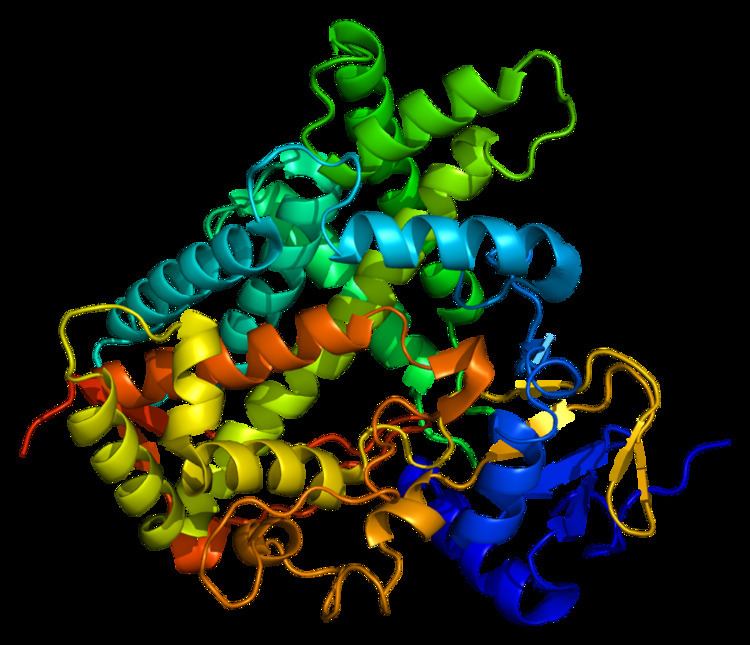EC number 1.14.13.48 | Entrez 1557 | |
 | ||
Aliases CYP2C19, CPCJ, CYP2C, CYPIIC17, CYPIIC19, P450C2C, P450IIC19, cytochrome P450 family 2 subfamily C member 19 External IDs HomoloGene: 133565 GeneCards: CYP2C19 | ||
Cytochrome P450 2C19 (abbreviated CYP2C19) is an enzyme. This protein, a member of the cytochrome P450 mixed-function oxidase system, is involved in the metabolism of xenobiotics, including many proton pump inhibitors and antiepileptics. In humans, the CYP2C19 protein is encoded by the CYP2C19 gene. CYP2C19 is a liver enzyme that acts on 10-15% of drugs in current clinical use, including the antiplatelet clopidogrel (Plavix), drugs that treat pain associated with ulcers, such as omeprazole, antiseizure drugs such as mephenytoin, the antimalarial proguanil, and the anxiolytic diazepam.
Contents
CYP2C19 has been annotated as (R)-limonene 6-monooxygenase and (S)-limonene 6-monooxygenase in UniProt.
Function
The gene encodes a member of the cytochrome P450 superfamily of enzymes. These proteins are monooxygenases that catalyze many reactions involved in drug metabolism and synthesis of cholesterol, steroids and other lipids. This protein localizes to the endoplasmic reticulum and is known to metabolize many drugs. Polymorphism within this gene is associated with variable ability to metabolize mephenytoin, known as the poor metabolizer and extensive metabolizer phenotypes. The gene is located within a cluster of cytochrome P450 genes on chromosome no.10 arm q24.
CYP2C19 also possesses epoxygenase activitiy: it is one of the principal enzymes responsible for attacking various long-chain polyunsaturated fatty acids at their double (i.e. alkene) bonds to form epoxide products that act as signaling agents. It metabolizes:
- arachidonic acid to various epoxyeicosatrienoic acids (also termed EETs);
- linoleic acid to 9,10-epoxy octadecaenoic acids (also termed vernolic acid, linoleic acid 9:10-oxide, or leukotoxin) and 12,13-epoxy-octadecaenoic (also termed coronaric acid, linoleic acid 12,13-oxide, or isoleukotoxin);
- docosohexaenoic acid to various epoxydocosapentaenoic acids (also termed EDPs); and
- eicosapentaenoic acid to various epoxyeicosatetraenoic acids (also termed EEQs).
Along with CYP2C19, CYP2C8, CYP2C9, CYP2J2, and possibly CYP2S1 are the main producers of EETs and, very likely EEQs, EDPs, and the epoxides of linoleic acid.
Genetic polymorphism and pharmacogenomics
Genetic polymorphism (mainly CYP2C19*2, CYP2C19*3 and CYP2C19*17) exists for CYP2C19 expression, with approximately 3–5% of Caucasian and 15–20% of Asian populations being poor metabolizers with no CYP2C19 function. This may reduce the efficacy of clopidogrel (Plavix). The basis for this reduced effect of clopidogrel in patients who have a gene of reduced activity may seem somewhat paradoxical, but can be understood as follows. Clopidogrel is administered as a “prodrug;” that is, a drug that is inactive when taken, and then depends on the action of an enzyme in the body in order to be activated. In patients who have a gene of reduced activity, clopidogrel may not be metabolized to its active form and therefore not achieve pharmacological effect in the body. In patients with an abnormal CYP2C19 variant certain benzodiazepines should be avoided, such as diazepam (Valium), lorazepam (Ativan), oxazepam (Serax), and temazepam (Restoril). On the basis of their ability to metabolize (S)-mephenytoin or other CYP2C19 substrates, individuals can be classified as extensive metabolizers (EM) or poor metabolizers (PM). Eight variant alleles (CYP2C19*2 to CYP2C19*8) that predict PMs have been identified.
Ligands
The following is a table of selected substrates, inducers and inhibitors of CYP2C19. Where classes of agents are listed, there may be exceptions within the class.
Inhibitors of CYP2C19 can be classified by their potency, such as:
